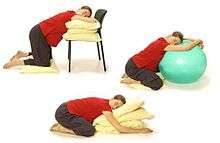Back labor

Back labor (less commonly called posterior labor[1][2]) is a term referring to sensations of pain or discomfort that occur in the lower back, just above the tailbone, to a mother during childbirth.[3]
Back labor may be noted when the baby is face up in the birth canal (occiput posterior), and not face down, so that the back of the baby's skull (occiput) is pushed against the mother's sacrum. But back labor can also occur when the baby is not in that position.[3] The discomfort is often noted to be intensely painful, and may not completely abate between contractions.[4] Whether back labor will occur cannot be predicted in advance. Reports of how many mothers experience back labor vary,[5] though estimates in the range of 30% are common.[6][7]
Actions that have been suggested to ameliorate back labor include physical activity, changing positions,[8] back rubbing, water massage, application of hot or cold to the lower back, use of a birthing ball[9] and medication including an epidural.[3][10] Some research has suggested that injecting sterile water into the lower back may provide pain relief, but there is no consensus that it actually helps.[11]
See also
References
- ↑ Moore, Mary Lou & Ora Strickland, Realities in Childbearing, p. 398 (1978) (using term "posterior labor")
- ↑ El Halta, Valerie Posterior Labor---A pain in the back!, ICAN Clarion 1996; 2(1)
- 1 2 3 Harms, Rogert W. Does back labor really happen?, mayoclinic.com, Retrieved 8 September 2014
- ↑ Klossner, N. Jayne. Introductory Nursing, Vol. 1, pp. 190, 432-33 (2006)
- ↑ Lieberman, Adrienne B. Easing Labor Pain: The Complete Guide to a More Comfortable and Rewarding Birth, p. 17 (1992) (This 1992 book says childhood educators typically cite 25%)
- ↑ Curtis, Glade B. & Schuler, Judith. Your Pregnancy After 35: Revised Edition, p. 290 (2001)
- ↑ Melzack, R. & D. Schaffelberg. Low-back pain during labor, Am J. Obstet Gynecol., 1987 Apr; 156 (4):901-05 (abstract) (1987 finding that "continuous low-back pain is severe and is reported by about 33% of women during labor.")
- ↑ Simkin, P. The fetal occiput posterior position: state of the science and a new perspective, Birth 2010 Mar; 37(1)l 61-71
- ↑ (25 July 2013). Positions and comfort measures to easy back labor, allparenting.com
- ↑ Murkoff, Heidi & Sharon Mazel. What to Expect When You're Expecting, p. 367-368 (4th ed. 2008)
- ↑ Derry, S.; Straube, S.; Moore, RA.; Hancock, H.; Collins, SL. (2012). Derry, Sheena, ed. "Intracutaneous or subcutaneous sterile water injection compared with blinded controls for pain management in labour". Cochrane Database Syst Rev. 1: CD009107. PMID 22258999. doi:10.1002/14651858.CD009107.pub2.